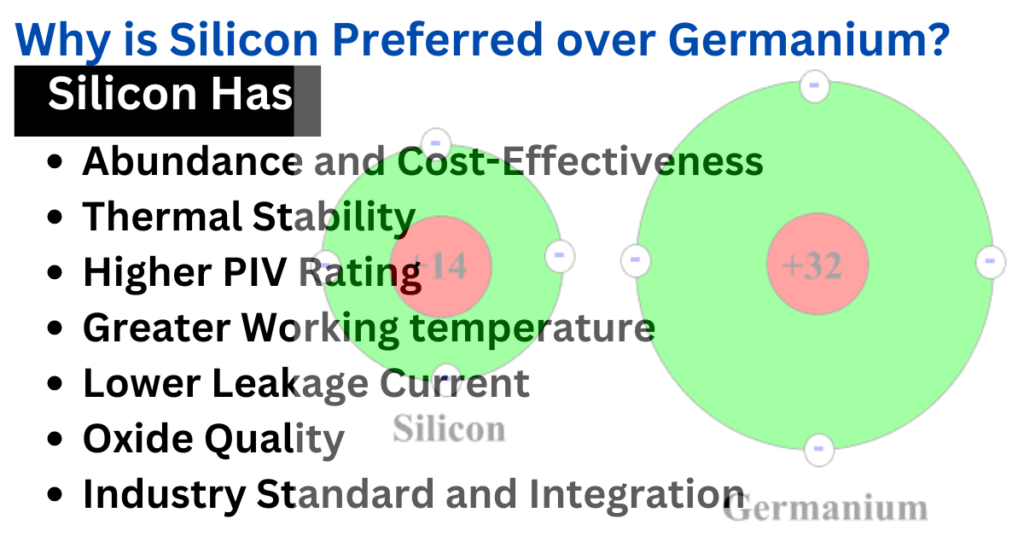Discover why silicon is preferred over germanium in semiconductor technology, focusing on factors such as cost, thermal stability, electrical properties, and industry integration.
In semiconductor technology, silicon and germanium play crucial roles due to their intrinsic properties as semiconducting materials. Historically, germanium was used in the early development of semiconductor devices. However, silicon has become the dominant material in the industry. This shift can be attributed to several key factors that favor silicon over germanium in most semiconductor applications.
Why is silicon preferred over germanium?

Abundance and Cost-Effectiveness
Silicon is the second most abundant element in the Earth’s crust after oxygen, making it readily available and significantly cheaper than germanium. This abundance leads to a lower cost for raw materials, which is a critical factor in large-scale production environments. In contrast, germanium is much rarer and, therefore, more expensive to procure, which limits its feasibility for widespread use in semiconductor manufacturing.
Thermal Stability
Silicon has a higher melting point (about 1414 degrees Celsius) compared to germanium (about 938 degrees Celsius). This higher thermal stability makes silicon more suitable for high-temperature applications, such as power electronics and automotive systems. Devices made from silicon can operate at higher temperatures without the risk of performance degradation, which is a significant advantage in ensuring the reliability and longevity of electronic components.
Electrical Properties
While both silicon and germanium are group IV elements and share similar electronic band structures, silicon’s larger band gap (1.12 eV at room temperature compared to germanium’s 0.66 eV) makes it more effective at maintaining its semiconducting properties at higher temperatures. The wider band gap reduces the leakage current in silicon-based devices, enhancing their performance in a broader range of temperatures and reducing power consumption, which is particularly important in mobile and computing applications. The following electrical properties of silicon make it superior to germanium.
Higher PIV Rating:
A silicon diode’s PIV (peak inverse voltage) value is approximately 1000 V, which is higher than that of germanium diodes. The PIV values for germanium diodes are closer to 400 V, while for silicon diodes, they are around 500-600 V.
Greater Working temperature:
Silicon can withstand high temperatures of up to 150 degrees Celsius without sustaining damage to its components. However, g-germanium can only handle temperatures of up to 70 degrees Celsius, and the structure of germanium can become damaged at temperatures exceeding 100 degrees Celsius.
Lower Leakage Current:
Leakage current can significantly impact performance in semiconductor devices, especially diodes and transistors. Devices made from materials with smaller band gaps (like Germanium) will inherently have higher leakage currents because more charge carriers are thermally generated. In contrast, the wider band gap of Silicon results in fewer carriers being thermally generated at the same temperature, thereby reducing the leakage current.
Oxide Quality
One of the most significant advantages of silicon in semiconductor technology is its ability to naturally form a stable, high-quality oxide layer (silicon dioxide) when exposed to oxygen. This oxide layer is integral in the manufacturing of electronic devices, serving as an insulator and protecting the pure silicon at the heart of the device. Silicon dioxide layers are used extensively to fabricate integrated circuits and microchips. They are crucial for the function of MOSFETs (metal-oxide-semiconductor field-effect transistors), which are the building blocks of most modern electronics. Germanium oxides, in contrast, are less stable and do not provide the same level of insulation and protection.
Industry Standard and Integration
The extensive history and evolution of silicon-based technology have led to a well-established industry standard that benefits from a vast body of research, development, and specialized equipment tailored specifically for silicon processing. This makes the integration of new silicon-based technologies into existing systems more seamless and cost-effective. Additionally, the semiconductor industry’s infrastructure and supply chain is optimized for silicon, which further discourages a shift towards germanium except in niche applications where its specific properties provide distinct advantages (like certain types of sensors and high-speed electronics).
Conclusion
Silicon’s dominance in semiconductor technology is based on a combination of material properties, economic factors, and industry standards that collectively outweigh the benefits offered by germanium in most practical applications. While germanium still has its uses in specialized fields, silicon’s versatility, cost-effectiveness, and excellent performance characteristics ensure that it remains the cornerstone of electronic device manufacturing, and therefore, silicon is preferred over germanium.